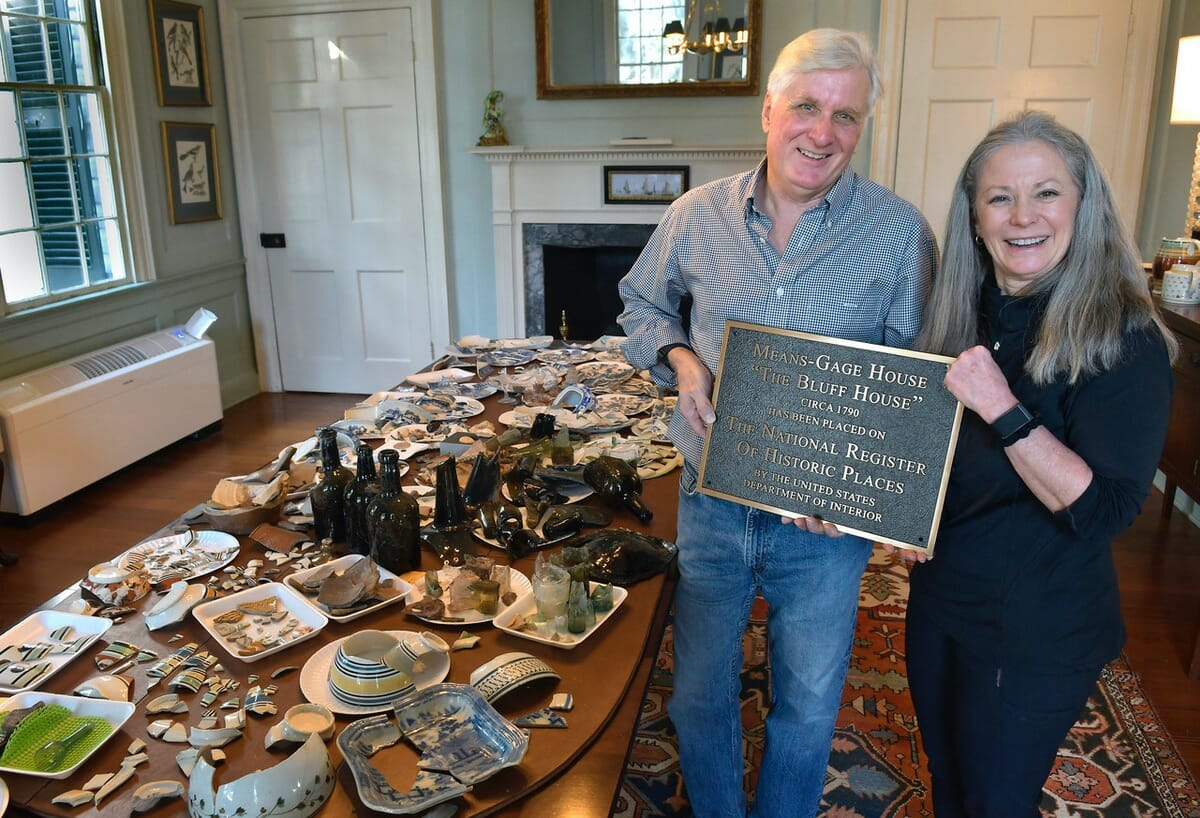Historic Bay Street home added to National Register of Historic Places
By Bob Sofaly
Catherine and Wallace Scarborough are standing in the living room of their Antebellum home at 1207 Bay Street. It’s big and welcoming … and full of garbage.
The garbage includes 230-year-old shards of pottery, bones and turtle shells recently excavated from an old privy in the back yard. Catherine Scarborough said, “they seemed to have eaten a lot of turtles back then.”
The home, known as the Means-Gage House, or The Bluff House, was recently named to the National Register of Historic Places by the U.S. Department of the Interior. The honor includes a large plague to be attached to the outside of the house and protection as a recognized historic building.

Wallace Scarborough repairs a broken tea cup, the pieces of which were unearthed in the 230-year-old privy recently excavated.
Catherine Scarborough said the house was built at the end of the 18th century. After endless hours of research she said, “We know (the house) is dated to 1790 because of the broken delftware we found” in the privy.
Delftware is traditionally white dishes, cups and tea pots with blue trim, also known as “Blue Willow.” The delftware dishes were manufactured in Liverpool, England in about 1790, she said. “The coins we found were issued in 1847”.
Along with the medicine bottles and the “black glass” bottles, the refuse represents a period from 1790 to the mid 1800s. “The artifacts we uncovered were pre-Civil War, which tells us they were used by the Means family, who first occupied the home.
The Means family, according to Wallace Scarborough, were significant in this area.
“They owned a plantation on Lady’s Island and one on Parris Island,” Wallace Scarborough said. He said they were very wealthy with a plantation house on the site of the French and Spanish fort where the Legends golf course currently sits on the Marine Corps Recruit Depot. Like most landowners of the period, they kept their families inland where it was cooler and had fewer mosquitoes.

Wallace and Catherine Scarborougho sort through artifacts found in a privy behind their home. Despite the traditional glass bottles and pottery shards, they found personal items like remnants of tooth brushes, jewelry and coins and bones of animals including lots of turtle shells.
“We did a full history renovation on the home which lasted from 2016 to 2018,” he said. “During the renovation, evidence was found indicating an even older site that may date back to about 1760.”
Part of the original structure seems to date back that far as well, predating the much larger structure by 30 years.
Catherine Scarborough said when old plaster was removed from some of the walls, there was evidence of an interior fire which may have occurred prior to the 1790 expansion of the home.
Both Catherine and Wallace said they wanted to protect the home and appealed to the U.S. Department of the Interior.
“Some very significant people who lived in this home through the years,” Wallace Scarborough said.
“We have letters between the Gages, who were strong abolitionists, to Clara Barton, founder and first president of the American Red Cross.”
Both Wallace and Catherine feel they don’t really own the house.
“We are just the custodians,” he said. “We take care of it and fix what needs to be fixed and keep old, historic buildings like this around.”







